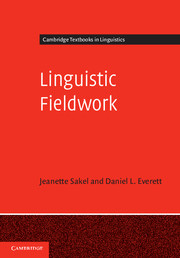1 - Introduction
What is linguistic fieldwork?
Published online by Cambridge University Press: 05 December 2012
Summary
Are you ready to ‘go to the field’? This book is written to prepare you for a great adventure: to discover a language, to use the skills you have learnt studying linguistics to document, describe and analyse how people use language. Your adventure may take you far away to a place you never heard of before, or you may simply talk to your next door neighbour. Linguistic fieldwork can be many things!
Have you ever wondered why your neighbour, who speaks both Urdu and English, sometimes switches between the two within the same sentence? Or have you always wanted to work on an ‘exotic’ language in a far-flung place? Or are you interested in a particular linguistic theory and want to figure out whether a theoretical notion can be found in language? In all three cases, doing linguistic fieldwork would be a way of finding out. You could record people's speech, carry out linguistic experiments or ask the speakers questions about their language use. These methods can be used on their own or in combination with one another.
Information
- Type
- Chapter
- Information
- Linguistic FieldworkA Student Guide, pp. 1 - 9Publisher: Cambridge University PressPrint publication year: 2012
